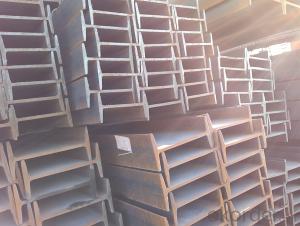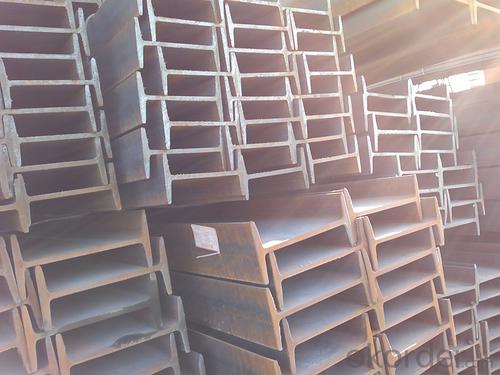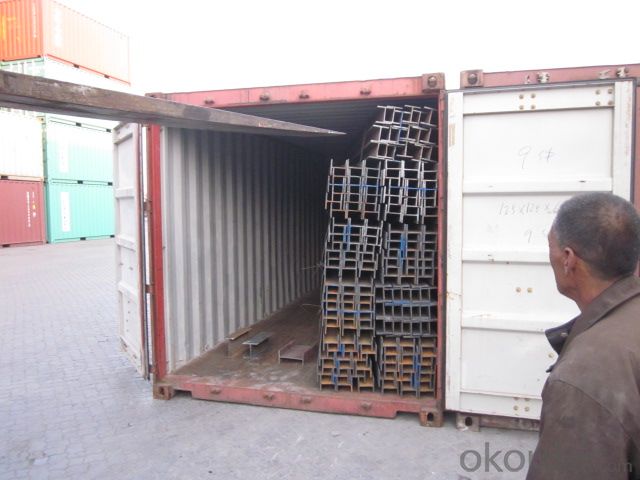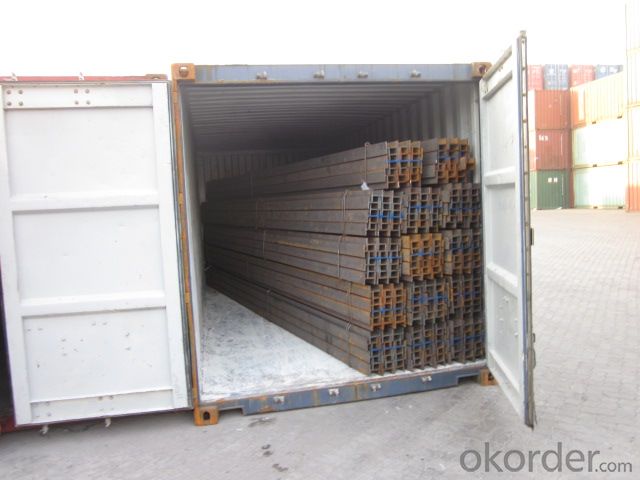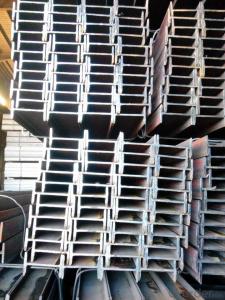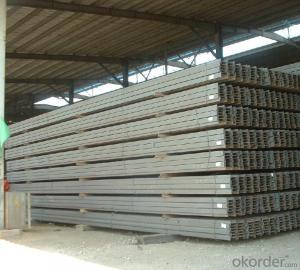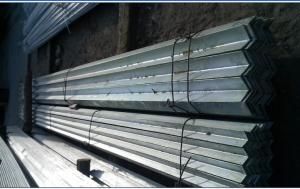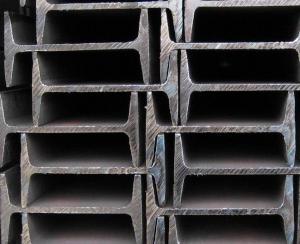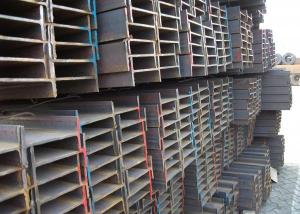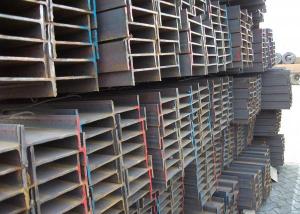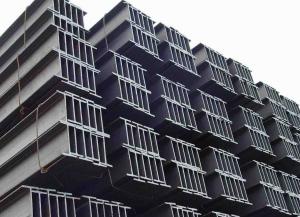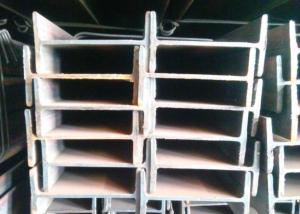EN STANDARD HIGH QUALITY LOWER CARBON IPE
- Loading Port:
- Tianjin
- Payment Terms:
- TT OR LC
- Min Order Qty:
- 5 m.t.
- Supply Capability:
- 1000 m.t./month
OKorder Service Pledge
OKorder Financial Service
You Might Also Like
Product Description:
Specifications of IPE Beam
1. Invoicing on theoretical weight or actual weight as customer request
2. Standard: EN10025, GB Standard, ASTM
3. Grade: Q235B, Q345B, SS400, ASTM A36, S235JR, S275JR
4. Length: 5.8M, 6M, 9M, 12M as following table
5. Sizes: 80mm-270mm
Dimensions(mm) | |||||
h | b | s | t | Mass Kg/m | |
IPE80 | 80 | 46 | 3.80 | 5.20 | 6.00 |
IPE100 | 100 | 55 | 4.10 | 5.70 | 8.10 |
IPE120 | 120 | 64 | 4.80 | 6.30 | 10.40 |
IPE140 | 140 | 73 | 4.70 | 6.90 | 12.90 |
IPE160 | 160 | 82 | 5.00 | 7.40 | 15.80 |
IPE180 | 180 | 91 | 5.30 | 8.00 | 18.80 |
IPE200 | 200 | 100 | 5.60 | 8.50 | 22.40 |
IPE220 | 220 | 110 | 5.90 | 9.20 | 26.20 |
IPE240 | 240 | 120 | 6.20 | 9.80 | 30.70 |
IPE270 | 270 | 135 | 6.60 | 10.20 | 36.10 |
Appications of IPE Beam
1. Supporting members, most commonly in the house raising industry to strengthen timber bears under houses. Transmission line towers, etc
2. Prefabricated structure
3. Medium scale bridges
4. It is widely used in various building structures and engineering structures such as roof beams, bridges, transmission towers, hoisting machinery and transport machinery, ships, industrial furnaces, reaction tower, container frame and warehouse etc.
Package & Delivery of IPE Beam
1. Packing: it is nude packed in bundles by steel wire rod
2. Bundle weight: not more than 3.5MT for bulk vessel; less than 3 MT for container load
3. Marks: Color marking: There will be color marking on both end of the bundle for the cargo delivered by bulk vessel. That makes it easily to distinguish at the destination port.
4. Tag mark: there will be tag mark tied up on the bundles. The information usually including supplier logo and name, product name, made in China, shipping marks and other information request by the customer.
If loading by container the marking is not needed, but we will prepare it as customer request.
5. Transportation: the goods are delivered by truck from mill to loading port, the maximum quantity can be loaded is around 40MTs by each truck. If the order quantity cannot reach the full truck loaded, the transportation cost per ton will be little higher than full load.
6. Delivery of IPE Beam: 30 days after getting L/C Original at sight or T/T in advance
Production flow of IPE Beam
Material prepare (billet) —heat up—rough rolling—precision rolling—cooling—packing—storage and transportation
- Q: What are the common connection methods for steel I-beams?
- Steel I-beams can be connected using different methods depending on the specific application and structural requirements. Some commonly used connection methods include: 1. Welding: Steel I-beams are often connected using welding, which involves melting and fusing the edges of the beams together using heat. This creates a strong and permanent bond. Welding can be done manually or using automated processes like robotic welding. 2. Bolting: Another common method is bolting, where bolts and nuts are used to secure the beams together. This method allows for easy disassembly and reassembly if necessary. 3. Riveting: Riveting involves using metal rivets to join the beams. Holes are drilled in the beams and rivets are inserted, then hammered or pressed to create a secure connection. Riveting was commonly used in the past but has been mostly replaced by welding and bolting due to the labor-intensive process. 4. Adhesive bonding: In specialized applications or situations where welding or bolting is not feasible, adhesive bonding is used. Industrial adhesives are used to bond the beams together. This method provides a strong and lightweight connection but may require additional surface preparation and curing time. It's important to consider various factors such as load-bearing capacity, steel type, structural design, and project constraints when choosing a connection method. Consulting with a structural engineer or following industry standards and regulations is crucial to ensure safe and effective connections for steel I-beams.
- Q: How do you calculate the shear force in steel I-beams?
- The shear force in steel I-beams can be calculated by determining the total load on the beam and then dividing it by the cross-sectional area of the beam. This will give the shear stress, which can then be multiplied by the area of the web of the beam to find the shear force.
- Q: How are steel I-beams made?
- Steel I-beams are made through a process known as hot rolling. It begins with raw steel, usually in the form of large billets or blooms, which are heated to extremely high temperatures. These heated steel pieces are then passed through a series of rollers to shape them into the distinctive I-beam profile. The first step in the hot rolling process is heating the steel to a temperature above its recrystallization point. This temperature range ensures that the steel is malleable and can be easily shaped without cracking or breaking. The heating process also removes any residual stresses and impurities from the steel. Once the steel is heated, it is guided through a series of rollers that gradually shape it into the desired I-beam profile. These rollers exert high pressure on the steel, causing it to elongate and take on the characteristic shape of an I-beam. The rollers are carefully designed to achieve the correct dimensions and ensure uniformity throughout the length of the beam. During the rolling process, the steel is continuously cooled to prevent it from overheating. This cooling process can be achieved through the use of water jets or air sprays. Cooling the steel helps to maintain its structural integrity and prevent any deformation or distortion. After the I-beam has been shaped and cooled, it undergoes a final finishing process. This may include cutting it to the required length, straightening any minor deviations, and inspecting it for any defects. The finished I-beams are then typically painted or coated to protect them from corrosion and improve their aesthetic appeal. Overall, the process of making steel I-beams involves heating the steel to high temperatures, passing it through rollers to shape it into the desired profile, cooling it to maintain its structural integrity, and applying finishing touches. This manufacturing process ensures that steel I-beams are strong, durable, and capable of supporting heavy loads in various construction applications.
- Q: What are the factors to consider when designing connections for steel I-beams?
- To achieve structural integrity and overall safety in steel I-beam connections, several factors must be considered. Here are some key considerations: 1. Load and stress analysis: Thoroughly examining the loads and stresses the I-beams will endure is crucial. This involves evaluating both static and dynamic loads, as well as potential future additional loads. The connection design should efficiently distribute these loads and stresses across the beams and connecting elements. 2. Connection type selection: Different connection types, such as bolted, welded, or a combination of both, are available for steel I-beams. Each type has its own advantages and limitations. Choosing the appropriate connection type should be based on load requirements, ease of installation, accessibility, and potential for future modifications or disassembly. 3. Compatibility with the surrounding structure: The connection design must be compatible with the overall structural system and existing connections. It should not cause conflicts or detrimental effects on surrounding elements or compromise the structure's performance. 4. Connection strength and rigidity: The connection design should provide sufficient strength and rigidity to resist applied loads and prevent excessive deflection or deformation. This requires considering the capacity of connected elements and ensuring the connection can transfer loads without failure or excessive movement. 5. Material compatibility: The materials used for connection elements (bolts, welds, or plates) should be compatible with the steel I-beams and possess similar mechanical properties. This ensures effective load transfer and the ability to withstand potential forces or deformations. 6. Fabrication and installation feasibility: The connection design should be practical and feasible for cost-effective and timely fabrication and installation. Factors like ease of access, standardization of connection details, and the availability of skilled labor or equipment for fabrication and installation must be considered. 7. Maintenance and future modifications: Ease of maintenance and potential future modifications to the connection should be considered. This includes providing access for inspection, repair, or component replacement, as well as accommodating changes or additions to the structure. By considering these factors, engineers can design connections for steel I-beams that meet performance criteria and ensure long-term durability and safety of the structure.
- Q: Can steel I-beams be used in data centers or server rooms?
- Yes, steel I-beams can be used in data centers or server rooms. Steel I-beams are commonly used in construction due to their strength and durability. In data centers and server rooms, where heavy equipment and racks are often installed, steel I-beams can provide the necessary support for the infrastructure. They can be used to create a structural framework that can bear the weight of servers, networking equipment, and other components. Additionally, steel I-beams can help distribute the load evenly and provide stability to the overall structure. However, it is important to ensure that the I-beams are properly designed and installed by qualified professionals to meet the specific requirements and regulations of data centers and server rooms.
- Q: Can steel I-beams be used in agricultural buildings?
- Yes, steel I-beams can be used in agricultural buildings. Steel I-beams are a popular choice for structural support in a variety of buildings, including agricultural structures. They offer several advantages such as high strength, durability, and resistance to pests, fire, and rot. Steel I-beams can provide the necessary load-bearing capacity to support the weight of equipment, livestock, and storage materials commonly found in agricultural buildings. Moreover, their versatility allows for flexible design options, making it easier to customize the building layout to suit specific agricultural needs. Overall, steel I-beams are a reliable and practical choice for constructing agricultural buildings.
- Q: What are the different methods of reinforcing steel I-beams against seismic forces?
- There are several methods to reinforce steel I-beams against seismic forces. One common method is using cross braces, which are diagonal steel members that connect the flanges of the I-beam, providing additional stiffness and resisting lateral forces. Another method is adding steel plates to the flanges and web of the I-beam, known as flange and web stiffeners, which increase the beam's resistance to bending and shearing. Additionally, steel channels or angles can be welded to the sides of the I-beam to enhance its strength and rigidity. These methods help to improve the overall performance and stability of steel I-beams during seismic events.
- Q: Can steel I-beams be used for industrial structures?
- Yes, steel I-beams can be used for industrial structures. Steel I-beams are commonly used in the construction industry due to their high strength-to-weight ratio, which allows for the creation of large and durable structures. Industrial structures such as warehouses, manufacturing plants, and power plants often require a strong and reliable support system, and steel I-beams provide the necessary structural integrity. Additionally, steel I-beams are versatile and can be easily fabricated and customized to meet specific design requirements, making them a preferred choice for industrial construction projects.
- Q: What material does I-beam have?
- Specifications: I-beam is mainly divided into ordinary steel, light I-beam and H steel three kinds.
- Q: How do steel I-beams handle vibrations from nearby railways or highways?
- The exceptional strength and durability of steel I-beams have earned them widespread recognition. This makes them an ideal choice for dealing with vibrations caused by nearby railways or highways. These structures are specifically designed to efficiently distribute loads, including dynamic loads like vibrations, across their entire length. When vibrations occur due to passing trains or heavy traffic, steel I-beams possess various features that help reduce their impact. Firstly, the stiffness and rigidity inherent in steel enable I-beams to effectively absorb and disperse vibrations, thereby minimizing their transmission to the surrounding structure. This is particularly advantageous in situations where sensitive equipment or structures are located in close proximity to railways or highways. Additionally, the configuration of I-beams, with their wide flanges and web, provides structural stability and resistance to bending and twisting forces. This ensures that the beams remain intact and functional even under significant vibrations. The specific design of I-beams also allows for optimal distribution of loads, further decreasing the potential for damage caused by vibrations. Furthermore, steel as a material possesses inherent damping properties, meaning it has the ability to absorb and dissipate energy. This property is advantageous in reducing the amplitude of vibrations that may be transmitted through the I-beams. The combination of steel's damping capabilities and the structural design of I-beams contributes to their effectiveness in handling vibrations from nearby railways or highways. To sum up, steel I-beams are well-suited to handle vibrations from nearby railways or highways due to their stiffness, structural stability, load distribution capabilities, and damping properties. These features work together to ensure that vibrations are effectively absorbed, dispersed, and minimized, thus protecting the integrity and functionality of surrounding structures.
Send your message to us
EN STANDARD HIGH QUALITY LOWER CARBON IPE
- Loading Port:
- Tianjin
- Payment Terms:
- TT OR LC
- Min Order Qty:
- 5 m.t.
- Supply Capability:
- 1000 m.t./month
OKorder Service Pledge
OKorder Financial Service
Similar products
Hot products
Hot Searches
Related keywords
